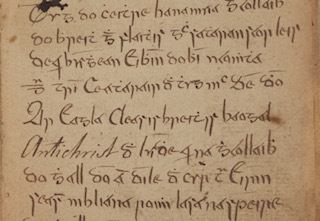
In 2021, the Hesburgh Library acquired a manuscript copy of Tuireamh na hÉireann (“Ireland’s Elegy”), which had been found tucked into a very battered Irish grammar, The Elements of the Irish Language Grammatically Explained in English, by Hugh McCurtin, which was published in 1728. Multiple names in the book and in the manuscript prompt us to speculate on its history. When did the manuscript and book come to America, and did they come together? We may not find answers, but we can explore.
Since the late 6th century, manuscripts have been central to the transmission of Ireland’s literature and culture in general, first in Latin, and then Irish (later still with increasing admixtures of English). The great bulk of our extant Irish-language manuscripts date from the 18th and 19th centuries and the vast majority of the copies of Tuireamh belong to this period. The number of surviving copies has been put at over 250, making it easily the most transcribed text in the entire corpus, testimony in and of itself to its influence.
Keating’s famous history of Ireland, Foras Feasa ar Éirinn (1634), which also circulated widely in manuscript, created what Breandán Ó Buachalla called “the origin legend of the emergent Irish Catholic nation.” Tuireamh is a historical poem of some 500 lines that gives a narrative summary of Keating’s history -which ended with the 11th century English conquest -and updates it to the catastrophic Cromwellian conquest, in the aftermath of which it was written. We know that people recited this poem, having memorized it, and that it also circulated widely in manuscript copies that were being made as late as the early 20th century.
When Lady Augusta Gregory collected folklore in her native Co. Galway from the late 19th century, she heard many stories of the blind poet Raftery. One of Raftery’s compositions was a long historical oral poem composed around 1825, a written copy of which she saw in a stonecutter’s cabin. The influence of Tuireamh is obvious in Raftery’s poem, as in other works, an indication of the former's extraordinary popularity. “More than any other literary work,” the historian Vincent Morley concludes, Tuireamh “taught the Gaelic version of history to the native population and made it a dominant narrative.”
Please join us on Friday, November 11th for a panel discussion on this important Irish manuscript.
Our event will be held in the Rare Books Reading Room (102 Hesburgh Library -- through the construction tunnel), at 4 p.m.
Panelists:
Sarah McKibben, Associate Professor and Chair, Irish Language and Literature
Peter McQuillan, Associate Professor of Irish Language and Literature
Aedín Ní Bhróithe Clements, Irish Studies Librarian
Diarmuid Ó Giolláin, Professor of Irish Language and Literature and Concurrent Professor of Anthropology